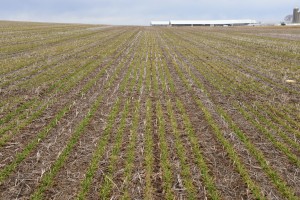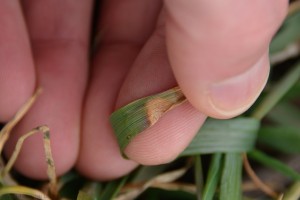Wisconsin Winter Wheat Disease Update – April 16, 2014
Damon L. Smith, Field Crops Extension Pathologist, University of Wisconsin-Madison
Figure 1. A stand of winter wheat at the Arlington Agriculture Research Station. Photo take April 11, 2014.
This week I scouted winter wheat in research trials located at the Arlington Agricultural research station. Wheat in the southern part of Wisconsin is starting to green up a bit (Fig. 1). In this location snow cover was pretty consistent throughout the very cold winter months. Survival of wheat plants was pretty good with the consistent snow cover. I was worried about snow mold development given the duration of snow cover this year, however, none was observed in this location.
I did observe Septoria leaf blotch on a few of the plants in these plots already this season. It is possible that the fungus infected these plants last fall, and the pathogen was able to overwinter. Regardless of when these initial infections took place, this is a disease we need to scout for now and keep track of through the season. If it is already present in wheat plots, then the base is set to build disease quickly if conditions are cool and wet this spring. In figure 2, you can see a lesion of Septoria leaf blotch with pycnidia (fruiting structures) that can produce lots of spores that can be rain splashed to other leaves and plants. Should the spring remain cool and wet, and a susceptible variety present, then this disease will increase and can cause enough damage to limit grain yield. To learn more about leaf blotch disease on wheat, consult the fact sheet located here: /files/2013/04/Leaf-Blotch-Diseases-of-Wheat-1.pdf.
Figure 2. A Septoria leaf blotch lesion on winter wheat. Note the black pimple-like fruiting structures (pycnidia) present in the center of the lesion. These structures are very diagnostic for Septoria leaf blotch.
Spraying when plants are very young (prior to jointing) isn’t generally recommended for this disease. However, spraying to protect the flag leaf and later growth stages during heading can help preserve yield when this disease is a problem. In 2013 we conducted a fungicide trial on wheat where Septoria leaf blotch was the main disease of concern. In that trial we found that applications of fungicide at the early flag leaf emergence stage (Feekes 8) gave us good control of Septoria leaf blotch, which translated into giving us a yield increase over not spraying or spraying prior to jointing (Feekes 5). To read more about the results of this fungicide trial, you can visit the webpage found at this link:/wheat/2013winterwheatfungicide/. It is a good idea to begin scouting now to determine what diseases are already present in wheat. Continue to watch weather forecasts as the crop matures and make plans for disease intervention measures (such as fungicide) if conducive disease conditions are present near flag leaf emergence later this season.
No other diseases were observed on winter wheat this week. Hopefully it will quite snowing and spring will arrive soon!




